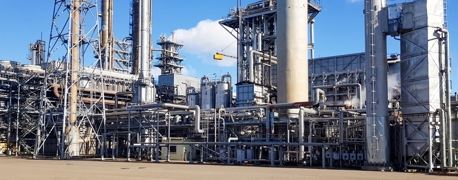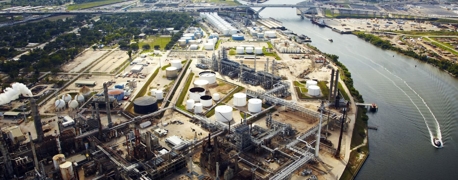Louisiana Plant Accidents Continue to Endanger Workers & Communities

Over the last several months, investigations have uncovered sobering truths as well as serious questions about a series of recent plant accidents in Louisiana’s Cancer Alley. Although they all took place at different industrial plants and refineries, and there were different types of incidents, they show how many corporations flout safety regulations, and how often this leaves workers, their families, and the communities near those plants paying the steep price for such negligence.
We’ll take a look at four such industrial plant accidents in turn, uncovering how this corridor of Louisiana earned its terrible moniker. We will examine the dangers they expose people to, and what companies should have done to prevent these accidents, injuries, and risks.
Reboiler Explosion at Honeywell Plant in Geismar, LA (2023)
On January 23, 2023, an explosion rocked a Honeywell facility in Geismar, Louisiana, releasing:
- More than 870 pounds of hydrogen fluoride
- Nearly 1,700 pounds of chlorine
- More than 1,700 pounds of HFC-245a, and
- 220 pounds of intermediate chemicals
Before this, around 7 p.m., the facility had suffered a power outage and was rebooting. Just over an hour later, a heat exchanger cracked and a reboiler exploded.
The Dangers Presented by These Chemicals
If hydrogen fluoride is inhaled, it can quickly harm the eyes, nose, and throat, and it can be absorbed through the skin, wreaking damage that even reaches deep tissues. This colorless gas can cause a respiratory burning sensation or bleeding, leading to nausea, vomiting, gastric distress, and it can even affect heart rhythms (cardiac arrhythmia). All of these symptoms could show up a week or more after exposure
Chlorine is a fire and explosion hazard that can irritate the eyes and throat, trigger a cough, and even affect the upper respiratory tract, causing some fluid buildup in lungs. Acute chlorine exposure can be fatal.
HFC-245fa is a refrigerant and spray foam blowing agent, a type of hydrofluorocarbon that OSHA deems hazardous. It is an explosion hazard, it can inflict frostbite, and it can also create suffocation risks.
The Effects
Highways close to the facility were shut down, and while thankfully no workers were in the immediate vicinity of the explosion, those onsite at the time of the incident were made to shelter in place. No injuries were reported. Property damage was valued at $4 million, and the faulty unit was offline for nearly 50 days.
What Went Wrong
According to an ongoing investigation by the U.S. Chemical Safety and Hazard Investigation Board (CSB), a 2021 inspection by Honeywell had determined that the shell on the reboiler needed to be replaced because of nearly a decade of corrosion. Honeywell had documentation that it was planning to buy a new reboiler shell back in January 2022 but failed to buy it and carry out the replacement. Then a year later, the reboiler predictably failed.
Honeywell also refused to tell CSB what the temperature and pressure of the reboiler was when the explosion occurred.
The CSB reported that it was still assessing Honeywell’s equipment policies, project management decisions, and standards. The fact that the company knew that the shell was on the verge of failure, yet didn't take that matter of simple maintenance seriously, is a clear example of how corporate negligence lets preventable accidents happen and endanger employees.
Marathon Petroleum Refinery Fire in Garyville, LA (2023)
August of 2023, a fire burst out and emitted chemicals for more than a dozen hours from a Marathon Petroleum refinery in Garyville, Louisiana. This refinery, which is right in the heart of the state’s infamous Cancer Alley, is the third largest oil refinery in the United States.
For more than three days, part of this nationally important refinery was on fire, and it continued to gush out hydrocarbon naphtha for more than 13 uninterrupted hours. This was more than half a day during which no alert was sent out to the surrounding neighborhoods. Marathon didn’t think to warn the people exposed to this toxic chemical during “one of the largest flammable chemical releases” that the Environmental Protection Agency (EPA) has ever documented.
The Chemicals Involved in This Refinery Fire & Possible Effects
This fire didn’t just create the normal air quality hazards that come with smoke and ash; it was a blaze that led to the widespread release of chemicals that are dangerous to encounter and inhale. One of the main chemicals released was naphtha, one of the materials used for creating gasoline.
Naphtha is regarded as a highly hazardous substance by the:
- Occupational Safety and Health Administration (OSHA)
- American Conference of Governmental Industrial Hygienists (ACGIH)
- National Institute for Occupational Safety and Health (NIOSH)
- National Fire Protection Association (NFPA)
Not only is naphtha exposure a danger in its own right, but it also contains the highly toxic chemical benzene. Outside investigations of this Marathon Petroleum fire found that some of the tanks that caught fire in this incident contained other highly toxic chemicals beyond naphtha, releasing dangerous substances such as polycyclic aromatic hydrocarbons (PAHs), chemicals that can cause cancer.
What Makes These Chemicals So Dangerous?
According to Marathon Petroleum’s own safety data, naphtha is flammable, corrosive to the skin, toxic to breathe in, and can lead to birth defects, organ damage, and more. Over time, naphtha exposure can lead to heightened cancer risks.
Known as a cause of many safety and health hazards, naphtha can:
- Burn skin and eyes on contact
- Sting and damage the throat and nose when breathed in
- Trigger asthma
- Cause headaches, dizziness, vomiting, nausea, loss of consciousness
- Threaten the nervous system and kidneys during prolonged exposure
The benzene found in naphtha and the PAHs released in this incident are chemicals that can cause a wide range of cancers, even at small levels of exposure. Benzene has also been linked with blood disorders and anemia, and PAHs have also been potentially linked to birth defects.
The Immediate & Long-Term Effects of This Refinery Fire
Despite the severe and documented dangers posed by such chemicals being released into the public, Marathon Petroleum has asserted that there were “no offsite impacts”, and that the air quality didn’t register any dangerous pollutants. Despite this assertion, dozens of people in the area were hospitalized with breathing troubles and other respiratory problems as a result of this incident.
Forensic Architecture (a research group) and journalists have investigated this claim from Marathon and found it suspect. It was uncovered that the neighboring communities had been exposed to benzene levels that were 18x more than what the CDC has listed for an acute exposure threshold. These investigators also found that Marathon took pains to underreport the impact of the toxic fire in its recounting of events to state and federal governments.
For instance, the tools that Marathon had used to monitor air quality as the fire raged would not have had the capacity to monitor PAHs, meaning there were no grounds to assert that this dangerous chemical wasn’t already flooding the communities nearby.
What Went Wrong
When working with something as flammable as naphtha, there are clear handling and storage requirements, firefighting methods, and planned responses to any accidental releases. For a fire to break out, there was a failure in at least one of these crucial safety processes.
Marathon reported to the state’s department of environmental quality (LDEQ) that the fire started at a corroded storage tank, a failure in toxic chemical storage and equipment maintenance.
Investigations also have questions about inadequate internal alerts, which meant there wasn’t a warning to alert and mobilize workers, and there are lingering issues with how plant managers were told to downplay the disaster when communicating with both local officials and refinery workers. Because naphtha and other unmonitored chemicals were released for 13 hours with no warnings given, this prevented people from evacuating in time to avoid exposure.
What’s Being Done
While Marathon claimed that no health risks were spread from the release of this dangerous chemical, there were immediate health effects and hospitalizations as a result, and more evidence mounts as time goes on and more symptoms develop.
A class action lawsuit has been filed by thousands of plaintiffs over this refinery fire, accusing Marathon of numerous violations that put people in harm’s way due its negligence and then downplaying that negligence. As the inevitable consequences of exposure to naphtha and other dangerous chemicals continue to tragically play out, it is only too likely that more plaintiffs will be joining that lawsuit or filing their own.
Ammonia Gas Leak at a Plastics Plant in Baton Rouge, LA (2023)
In the evening of October 8 of 2023, a storage cylinder that held as much as 150 pounds of ammonia ruptured, which quickly engulfed nearby workers before dissipating into the air. This took place at the Formosa Plastics plant in Baton Rouge, Louisiana.
The Immediate Effects of This Tank Explosion
This ammonia leak seriously injured and hospitalized four workers. They were treated at Baton Rouge General Hospital’s emergency room with chemical burns due to inhalation, with two of the workers reported in critical condition.
Officials told the surrounding community that the exposure would not affect the public, claiming the harm was restricted to those in the immediate vicinity of the ammonia leak.
Why an Ammonia Leak Is So Terrible
One of the most common chemicals in American industrial processes, ammonia is found in cleaning products and often used on farms and industrial sites. It is extremely dangerous to inhale. A caustic chemical, ammonia can burn the nose, throat, and even the entire respiratory tract, burning everywhere from the mouth all the way to the lungs. It can also burn the skin and eyes. If exposed to enough ammonia at once, someone can lose their eyesight, suffer permanent lung injury, or even die.
According to OSHA, acute exposure to ammonia can be “immediately dangerous to life and health.”
What Formosa Plastics Got Wrong
Leading up to this incident, Formosa Plastics had been repeatedly hit with multiple citations for violating both safety and environmental regulations. Specifically, the EPA had issued dozens of citations from 2000 onward for the plant’s failure to contain its vinyl chloride and other life-threatening, cancer-causing chemicals. The company has been labeled noncompliant by the EPA since 2009, for its vinyl chloride emissions and its failures to inspect emergency relief valves.
This petrochemical factory, which makes polyvinyl chloride (PVC) for everything from pipes to food wrap, had reported multiple leaks in the four years before this ammonia leak. The facility repeatedly had leaks that involved vinyl chloride and ethylene dichloride.
This company was a known violator of safety procedures, while at the same time, deregulation meant that safety practices were not being adequately enforced by outside parties. Nothing was changing or being done to force Formosa Plastics’ hand to keep its workers and surrounding communities safe. It was under this culture of disregard for worker safety around hazardous substances that this ammonia leak then occurred. The Baton Rouge Fire Department said the leak happened because of a faulty cylinder, something that proper maintenance and inspections could have prevented.
Fire at Chevron Energy Plant in Geismar, LA (2024)
Two people were injured and hospitalized after a fire broke out at a Chevron Renewable Energy Group plant on the morning of September 19, 2024. An hour after the blaze erupted, the flames were entirely out, and the damage hadn’t spread beyond the chemical plant itself. The source of the fire is still being investigated.
The Dangers of an Energy Plant Fire
This plant makes renewable diesel, with green hydrogen being touted as safer than other fuels of its kind. Still, hydrogen gas is extremely flammable and can quickly ignite. Hydrogen gas requires stringent storage and handling measures in order to prevent explosions and fires, especially since leaks cannot be detected with the naked eye. Hydrogen fires themselves are nearly invisible.
One of the hospitalized workers had sustained burns over 15% of his body and was being treated in serious condition. The other worker was discharged later that day after being treated for 2% burns.
What Went Wrong
Hydrogen gas does not spontaneously explode or ignite. It first has to come into contact with something else, like oxygen.
That is why there are stringent regulations for hydrogen storage, such as:
- Specific storage tanks designs made of the right materials
- Appropriate storage locations away from falling object and vehicle collision risks
- Well-ventilated areas to house the tanks
- The right temperature conditions, etc.
- Advanced sensors to warn against any leaks
- Fire suppression systems in place
As hydrogen gas has no odor, flavor, or color, emergency detectors and valves need to be in place and kept in good working condition.
For hydrogen to explode and burst into flames, something went wrong along the way in both storage measures and leak detection and fire suppression. Specifically, something went wrong with how Chevron stored the hydrogen, maintained these tanks, designed and built its plant, and/or trained its employees in working around this dangerous chemical.
As is the case with so many plant accidents, employer negligence endangers workers through the preventable tragedies that strike because of the company cutting corners.
The Response
The injured workers had to be air lifted to Baton Rouge General’s burn unit, and the plant was shut down for one day. While there is no word on whether the harmed employees took legal action, medical professionals in the area are the ones who took steps to respond appropriately to this type of emergency.
According to Alyson Hughes, the Emergency Management Coordinator for Baton Rouge General, the hospital anticipates having to treat industrial workers throughout the year for burns and other injuries due to exposure to hazardous substances. They run specific training in order to prepare for these specific types of burns, as well as train personnel to handle more extreme cases that would require full-scale decontamination measures. The expectation is that local corporations won’t keep their employees safe, so local hospitals have prepared to step up to help with the anticipated casualties.
Industrial Corporations That Are Negligent Need to Be Held Accountable
While this is a small sample of recent industrial accidents, these examples are taken from within a small span of time and are hardly exhaustive. Louisiana’s refineries and plants have a well-documented history of catastrophic and deadly accidents, failures on the part of corporations that expose workers to toxic substances and put the surrounding communities at risk by failing to abide by safety regulations.
Even when companies are cited for failing to provide adequate training, equipment, maintenance, and more, the harm has already been done. Investigations are slow-moving and lengthy, and if any fines are levied, they are a pittance compared to what these international companies make. And so, negligence goes unchecked and continues to cost workers and communities, not the companies that operate recklessly.
While this is immediately in the context of the dangers unique to working with hazardous chemicals, this pattern of disregarding safety regulations reveals itself in other types of workplace accidents as well, from forklift accidents to fall injuries and more. Whatever type of accidents occur at a Louisiana plant, they consistently prove to have been preventable and predictable, something for which the employer is at fault. While regulatory agencies often fail to affect change, and journalists can expose wrongdoings, individuals and families who take legal action can often forge their own path to getting answers and demanding justice.
- Categories


